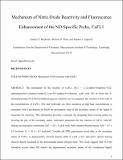Mechanism of Nitric Oxide Reactivity and Fluorescence Enhancement of the NO-Specific Probe CuFL1
Author(s)
McQuade, Lindsey E.; Pluth, Michael D.; Lippard, Stephen J.
DownloadMcQuade et al Inorg Chem.pdf (912.6Kb)
PUBLISHER_POLICY
Publisher Policy
Article is made available in accordance with the publisher's policy and may be subject to US copyright law. Please refer to the publisher's site for terms of use.
Terms of use
Metadata
Show full item recordAbstract
The mechanism of the reaction of CuFL1 (FL1 = 2-{2-chloro-6-hydroxy-5-[(2-methylquinolin-8-ylamino)methyl]-3-oxo-3H-xanthen-9-yl}benzoic acid) with nitric oxide (NO) to form the N-nitrosated product FL1-NO in buffered aqueous solutions was investigated. The reaction is first-order in [CuFL1], [NO], and [OH−]. The observed rate saturation at high base concentrations is consistent with a mechanism in which the protonation state of the secondary amine of the ligand is important for reactivity. This information provides a rationale for designing faster-reacting probes by lowering the pKa of the secondary amine. Activation parameters for the reaction of CuFL1 with NO indicate an associative mechanism (ΔS‡ = −120 ± 10 J/mol·K) with a modest thermal barrier (ΔH = 41 ± 2 kJ/mol; Ea = 43 ± 2 kJ/mol). Variable-pH electron paramagnetic resonance experiments reveal that, as the secondary amine of CuFL1 is deprotonated, electron density shifts to yield a new spin-active species having electron density localized on the deprotonated amine nitrogen atom. This result suggests that FL1-NO formation occurs when NO attacks the deprotonated secondary amine of the coordinated ligand, followed by inner-sphere electron transfer to Cu(II) to form Cu(I) and release of FL1-NO from the metal.
Date issued
2010-09Department
Massachusetts Institute of Technology. Department of ChemistryJournal
Inorganic Chemistry
Publisher
American Chemical Society
Citation
McQuade, Lindsey E., Michael D. Pluth, and Stephen J. Lippard. “Mechanism of Nitric Oxide Reactivity and Fluorescence Enhancement of the NO-Specific Probe CuFL1.” Inorganic Chemistry 49.17 (2010): 8025-8033.
Version: Author's final manuscript
ISSN
0020-1669
1520-510X